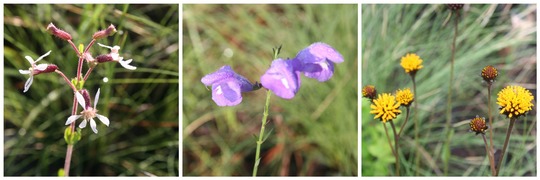FOR IMMEDIATE RELEASE: June 23, 2014
RARE PLANT SPECIES
BLOSSOM AFTER PRESCRIBED BURN
~Fire brings rare plants back to life~
 From left to right: tropical waxweed, Florida skullcap and Chapman's Crownbeard.
ST. JOSEPH BAY –
Significant discoveries at a Northwest Florida Buffer Preserve are creating
excitement for scientists, staff and residents alike. Several new sites of
five rare plants were recently discovered at St. Joseph Bay State Buffer
Preserve by Allix North, park service specialist. These plants appeared after
a prescribed burn of conservation land this spring, which had no recorded
previous burn history. The new plants are tropical waxweed (Cuphea aspera), Florida skullcap (Scutellaria floridana), Chapman’s
Crownbeard (Verbesina chapmanii), bog
tupelo (Nyssa ursina) and Telephus
spurge (Euphorbia telephioides).
Tropical waxweed is considered
imperiled and Florida skullcap is listed as endangered in Florida and
threatened in the United States. Chapman’s Crownbeard is labeled as globally
vulnerable. These plants are very rare and are part of more than 20 species of
rare, protected plants that have been documented on the St. Joseph Bay State
Buffer Preserve lands.
Prescribed burning takes place
on Buffer Preserve lands to keep the natural communities of plants and animals
healthy and help prevent destructive wildfires. The burn itself clears the
forest floor of vegetation creating a clean slate for new growth, and at the
same time releasing much needed nutrients back into the soil that is stored
within the plants. The fire-dependent plants that thrive within the Buffer
Preserve are able to recover quickly after a prescribed burn either through
re-sprouting or the seed bank within the soil.
“The survey of the prescribed
burn area brought about many new exciting plant sites.
This survey process will continue monthly, for the next year, with the hope that
more new sites will be discovered, and other rare or endangered plants
will begin to grow and bloom,” said Park Service Specialist Allix North. “The opportunity to find new plants
is fantastic and the idea that new life comes from fire is what makes natural plant communities wonderful."
The foresight to conserve the
property by the Florida Department of Environmental Protection has been
critical. As a coastal buffer of undeveloped land it protects the waters of
the St. Joseph Bay Aquatic Preserve keeping water quality high in an important
seafood production area. It also conserves the historical cultural and
pre-Columbian sites on the uplands. The area offers researchers remarkable
opportunities, while allowing the public sustainable recreational access.
First Fridays at the Buffer Preserve offer tram tours which
introduce the flora and fauna of the Buffer Preserve. You can click HERE to
make a reservation.
|